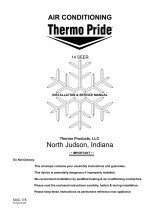
Page 9
Manual 2100-292
Installation Instructions — CMA-2
Disconnect all power to unit. Remove control panel cover.
Step 1. Snap control assembly into control panel as shown in
Figure 5.
Step 2. Disconnect yellow low voltage (Y) wire at compressor
contactor coil or (Y1) at optional CMA-5 and reconnect
to terminal #4 of the lockout relay.
Step 3. Connect yellow wire from terminal #3 of the low
pressure bypass TDR to the (Y) terminal of the
compressor contactor coil or (Y1) at optional CMA-5.
This is the terminal that the wire was removed from in
Step 2.
Step 4. Connect the black wire from terminal H of the low
pressure bypass TDR to the common (C) side of the
compressor contactor coil.
Step 5. Route low (blue) pressure switch wires up through the
bushing in the bottom of the control panel. Connect low
pressure switch wires between terminals #1 and #3 of
the low pressure bypass TDR.
Step 6. Remove service port caps on the suction line. Install the
low pressure switch on the suction line with the flare
tee adapter that is brazed to the low pressure switch.
Check for pressure at the flare tee dill valves after
installation to insure that the dill valve in the unit
service port was depressed by the flare tee connector.
Check for leaks at the flare tee connectors. Replace
service port caps on the flare tee service ports and
tighten.
Step 7. Recheck wiring. See Figure 7. Check for proper
operation of the unit by energizing in heating or cooling
mode for at least 5 minutes. The unit should not go into
lockout.
Step 8. Replace all panels and covers. This completes
installation.
Figure 7 — Installation Instructions for
CMA-2 Low Pressure Control
MIS-596
MIS-595
Installation Instructions — CMA-4
Disconnect all power to unit. Remove control panel cover.
Step 1. Snap control assembly into control panel as shown in
Figure 5.
Step 2. Disconnect yellow low voltage (Y) wire at compressor
contactor coil or (Y1) at optional CMA-5 and
reconnect to terminal #4 of the lockout relay.
Step 3. Connect yellow wire from terminal #3 of the low
pressure bypass TDR to the (Y) terminal of the
compressor contactor coil or (Y1) at optional CMA-5.
This is the terminal that the wire was removed from in
Step 2.
Step 4. Connect the black wire from terminal H of the low
pressure bypass TDR to the common (C) side of the
compressor contactor coil.
Step 5. Route high (red) and low (blue) pressure control wires
up through the bushing in the bottom of the control
panel. Connect low pressure control wires between
terminals #1 and #3 of the low pressure bypass TDR.
Step 6. Connect the high pressure control wires between
terminal #5 of the lockout relay and terminal #1 of the
low pressure bypass TDR.
Step 7. Remove service port caps on both the suction and
discharge lines. Install the high pressure control on the
discharge line with the flare tee adapter that is brazed
to the high pressure switch. Install the low pressure
control on the suction line. Check for pressure at the
flare tee dill valves after installation to insure that the
dill valve in the unit service port was depressed by the
flare tee connector. Check for leaks at the flare tee
connectors. Replace service port caps on the flare tee
service ports and tighten.
Step 8. Recheck wiring. Refer to Figure 8. Check for proper
operation of the unit by energizing in heating or
cooling mode for at least 5 minutes. The unit should
not go into lockout.
Step 9. Apply “This unit equipped with CMA-4 control
module” label to inside of inner control panel cover
above wiring diagram. Leave these instructions in
the unit.
Step 10. Replace all panels and covers. This completes
installation.
Figure 8 — Installation Instructions for
CMA-4 High and Low Pressure Control
MIS-595





















